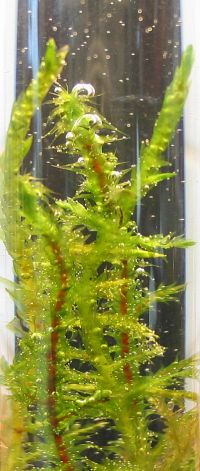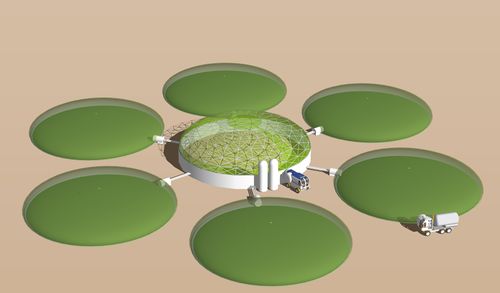Difference between revisions of "Algae"
(Emergency Light) |
|||
| (5 intermediate revisions by 5 users not shown) | |||
| Line 1: | Line 1: | ||
[[Image:alga_and_bubbles.jpg|thumb|right|200px|Algae in algaculture with bubbles of oxygen]] | [[Image:alga_and_bubbles.jpg|thumb|right|200px|Algae in algaculture with bubbles of oxygen]] | ||
| − | + | [[File:Food dome group.jpg|thumb|500x500px|A conceptual aerated tank farm of the surface of Mars. The thermal inertia of water should prevent the tanks from freezing, and the use of infrared reflective membranes and multiwalled tanks could allow the heat to build up to useful temperatures. Very hypothetical. ]] | |
'''Algae''' are a diverse group of organisms, ranging from ten meter long kelp to [[microbes|unicellular]] dinoflagellate. These organisms are a vital link in many food chains on [[Earth]]. The farming of algae is called [[algaculture]]. | '''Algae''' are a diverse group of organisms, ranging from ten meter long kelp to [[microbes|unicellular]] dinoflagellate. These organisms are a vital link in many food chains on [[Earth]]. The farming of algae is called [[algaculture]]. | ||
| Line 6: | Line 6: | ||
===Open Pools=== | ===Open Pools=== | ||
| − | Open pools are similar to the natural environment of many species of algae. | + | Open pools are similar to the natural environment of many species of algae. |
===Aerated Tanks=== | ===Aerated Tanks=== | ||
| Line 26: | Line 26: | ||
===Emergency Light=== | ===Emergency Light=== | ||
| − | Special algae produce light. <ref>[http://www. | + | Special algae produce light.<ref>[http://www.wikihow.com/Grow-Bioluminescent-Algae-at-Home How to Grow Bioluminescent Algae at Home]</ref> If placed in a sun-lit room, it produces oxygen and proteins during the day. At night it consumes part of the previously produced substances and gives a little light for the settlers, not for other plants to grow. I can imagine those lamps can be useful as an emergency illumination, or may be, if regularly carried towards the living quarters in the evening, as an alternative lighting technology for the living quarters. |
| + | |||
| + | ===CO2 eating algae=== | ||
| + | All algae feed off CO2 as well as sunlight to produce hydrocarbons for their structure and to store energy in oils, fats and sugars.<ref>[http://www.geek.com/news/biochemist-creates-co2-eating-light-that-runs-on-algae-1487699/ Biochemist creates CO2-eating light that runs on algae]</ref> Oxygen is a byproduct of photosynthesis. CO2 production can continue the dark and can help to clean the air in the Martian settlement. | ||
| + | |||
| + | ==Production== | ||
| + | In the right climate on Earth, algae farms can produce 100 tonnes per hectare of biomass. <ref>http://franke.uchicago.edu/bigproblems/Team1-1209.pdf</ref> This compares to about 80 tonnes per hectare for tomatoes in greenhouses, and about 3-10 tonnes per hectare for many crops such as rice, corn and wheat. As Mars gets roughly half the sunlight Earth does, a production rate of 50 tonnes per hectare might eventually be possible. The energy conversion rate of photosynthesis driving this production is about 3-4%.<ref>https://en.wikipedia.org/wiki/Photosynthetic_efficiency</ref> The plant uses most of this energy to build itself and support its internal processes, so the yield of oil producing algae might be about 0,3 to 1%. the average yield of crops is about 2% by mass and 1% of edible components. Some types of algae produce about 40% oil by mass. | ||
| − | + | A large support infrastructure to produce the necessary fertilizers, clean the water, control the plants genetics, gather the algae and control the environment would be required. | |
| − | |||
==References== | ==References== | ||
| − | <references/> | + | <references /> |
[[category:biospherics]] | [[category:biospherics]] | ||
| − | |||
Latest revision as of 08:36, 17 May 2019
Algae are a diverse group of organisms, ranging from ten meter long kelp to unicellular dinoflagellate. These organisms are a vital link in many food chains on Earth. The farming of algae is called algaculture.
Contents
Cultivation of Algae
Open Pools
Open pools are similar to the natural environment of many species of algae.
Aerated Tanks
Aerated tanks provide a controllable environment which can be tuned to the exact conditions needed by the target species.
Uses of Algae
Food
Algae are an excellent source of vitamins, oils, fatty acids, and minerals, and are eaten in many parts of the world. They can be grown in tanks filled with waste water, and aerated with CO2 from the martian atmosphere. A welcome side effect is the release of free oxygen.
Fertilizer
Algae is currently used on Earth as a fertilizer.
Waste Water Treatment
Algae digest excess organic molecules and CO2.
Chemosynthesis
Certain species of algae can be grown to produce hydrogen and hydrocarbons.
Emergency Light
Special algae produce light.[1] If placed in a sun-lit room, it produces oxygen and proteins during the day. At night it consumes part of the previously produced substances and gives a little light for the settlers, not for other plants to grow. I can imagine those lamps can be useful as an emergency illumination, or may be, if regularly carried towards the living quarters in the evening, as an alternative lighting technology for the living quarters.
CO2 eating algae
All algae feed off CO2 as well as sunlight to produce hydrocarbons for their structure and to store energy in oils, fats and sugars.[2] Oxygen is a byproduct of photosynthesis. CO2 production can continue the dark and can help to clean the air in the Martian settlement.
Production
In the right climate on Earth, algae farms can produce 100 tonnes per hectare of biomass. [3] This compares to about 80 tonnes per hectare for tomatoes in greenhouses, and about 3-10 tonnes per hectare for many crops such as rice, corn and wheat. As Mars gets roughly half the sunlight Earth does, a production rate of 50 tonnes per hectare might eventually be possible. The energy conversion rate of photosynthesis driving this production is about 3-4%.[4] The plant uses most of this energy to build itself and support its internal processes, so the yield of oil producing algae might be about 0,3 to 1%. the average yield of crops is about 2% by mass and 1% of edible components. Some types of algae produce about 40% oil by mass.
A large support infrastructure to produce the necessary fertilizers, clean the water, control the plants genetics, gather the algae and control the environment would be required.








